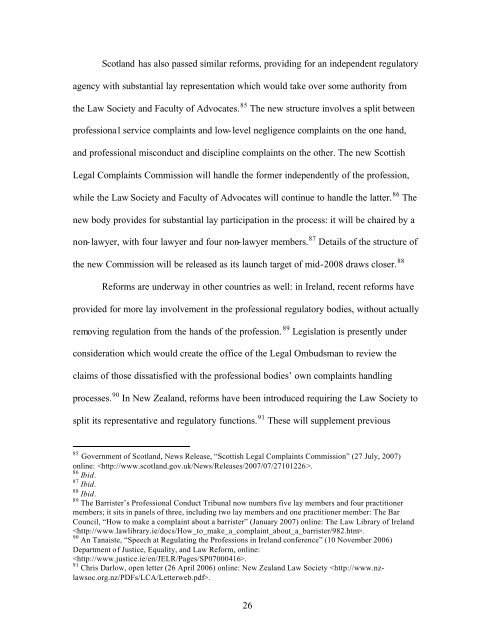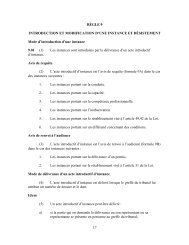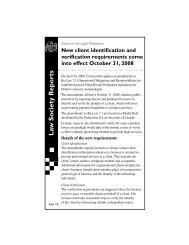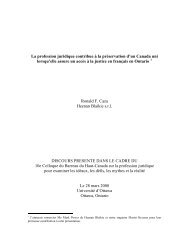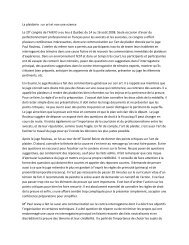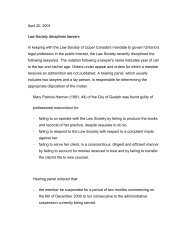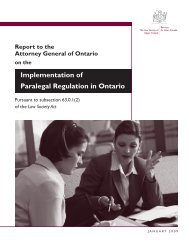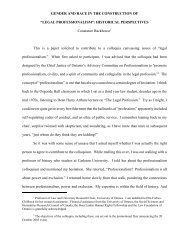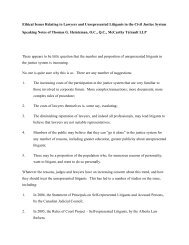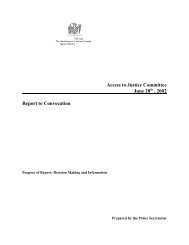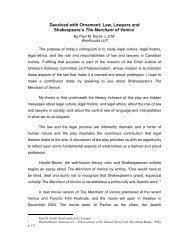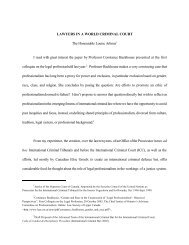of self regulation? - The Law Society of Upper Canada
of self regulation? - The Law Society of Upper Canada
of self regulation? - The Law Society of Upper Canada
Create successful ePaper yourself
Turn your PDF publications into a flip-book with our unique Google optimized e-Paper software.
Scotland has also passed similar reforms, providing for an independent regulatory<br />
agency with substantial lay representation which would take over some authority from<br />
the <strong>Law</strong> <strong>Society</strong> and Faculty <strong>of</strong> Advocates. 85 <strong>The</strong> new structure involves a split between<br />
pr<strong>of</strong>essional service complaints and low-level negligence complaints on the one hand,<br />
and pr<strong>of</strong>essional misconduct and discipline complaints on the other. <strong>The</strong> new Scottish<br />
Legal Complaints Commission will handle the former independently <strong>of</strong> the pr<strong>of</strong>ession,<br />
while the <strong>Law</strong> <strong>Society</strong> and Faculty <strong>of</strong> Advocates will continue to handle the latter. 86 <strong>The</strong><br />
new body provides for substantial lay participation in the process: it will be chaired by a<br />
non-lawyer, with four lawyer and four non-lawyer members. 87 Details <strong>of</strong> the structure <strong>of</strong><br />
the new Commission will be released as its launch target <strong>of</strong> mid-2008 draws closer. 88<br />
Reforms are underway in other countries as well: in Ireland, recent reforms have<br />
provided for more lay involvement in the pr<strong>of</strong>essional regulatory bodies, without actually<br />
removing <strong>regulation</strong> from the hands <strong>of</strong> the pr<strong>of</strong>ession. 89 Legislation is presently under<br />
consideration which would create the <strong>of</strong>fice <strong>of</strong> the Legal Ombudsman to review the<br />
claims <strong>of</strong> those dissatisfied with the pr<strong>of</strong>essional bodies’ own complaints handling<br />
processes. 90 In New Zealand, reforms have been introduced requiring the <strong>Law</strong> <strong>Society</strong> to<br />
split its representative and regulatory functions. 91 <strong>The</strong>se will supplement previous<br />
85 Government <strong>of</strong> Scotland, News Release, “Scottish Legal Complaints Commission” (27 July, 2007)<br />
online: .<br />
86 Ibid.<br />
87 Ibid.<br />
88 Ibid.<br />
89 <strong>The</strong> Barrister’s Pr<strong>of</strong>essional Conduct Tribunal now numbers five lay members and four practitioner<br />
members; it sits in panels <strong>of</strong> three, including two lay members and one practitioner member: <strong>The</strong> Bar<br />
Council, “How to make a complaint about a barrister” (January 2007) online: <strong>The</strong> <strong>Law</strong> Library <strong>of</strong> Ireland<br />
.<br />
90 An Tanaiste, “Speech at Regulating the Pr<strong>of</strong>essions in Ireland conference” (10 November 2006)<br />
Department <strong>of</strong> Justice, Equality, and <strong>Law</strong> Reform, online:<br />
.<br />
91 Chris Darlow, open letter (26 April 2006) online: New Zealand <strong>Law</strong> <strong>Society</strong> .<br />
26


